Denis Parra
Perceptual Evaluation of GANs and Diffusion Models for Generating X-rays
Aug 10, 2025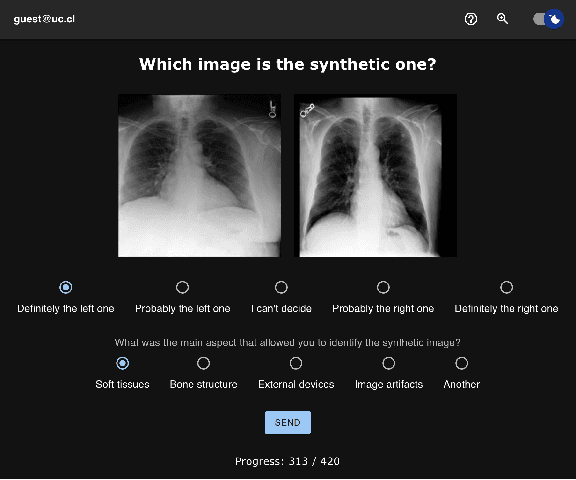
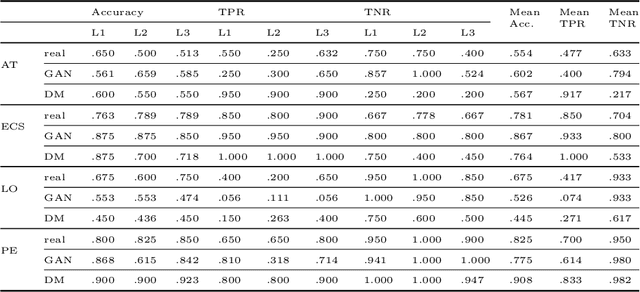
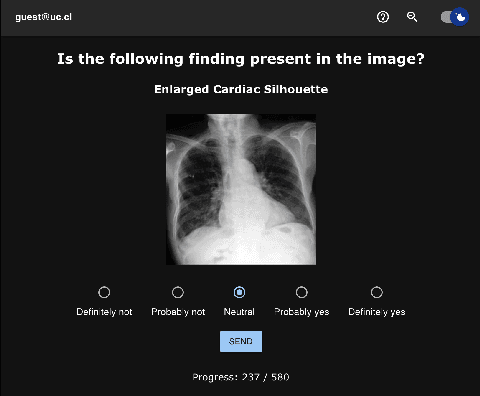
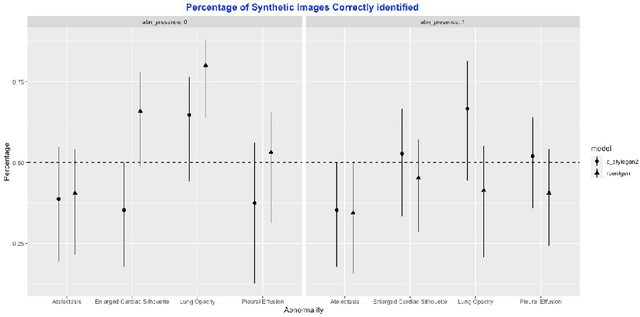
Abstract:Generative image models have achieved remarkable progress in both natural and medical imaging. In the medical context, these techniques offer a potential solution to data scarcity-especially for low-prevalence anomalies that impair the performance of AI-driven diagnostic and segmentation tools. However, questions remain regarding the fidelity and clinical utility of synthetic images, since poor generation quality can undermine model generalizability and trust. In this study, we evaluate the effectiveness of state-of-the-art generative models-Generative Adversarial Networks (GANs) and Diffusion Models (DMs)-for synthesizing chest X-rays conditioned on four abnormalities: Atelectasis (AT), Lung Opacity (LO), Pleural Effusion (PE), and Enlarged Cardiac Silhouette (ECS). Using a benchmark composed of real images from the MIMIC-CXR dataset and synthetic images from both GANs and DMs, we conducted a reader study with three radiologists of varied experience. Participants were asked to distinguish real from synthetic images and assess the consistency between visual features and the target abnormality. Our results show that while DMs generate more visually realistic images overall, GANs can report better accuracy for specific conditions, such as absence of ECS. We further identify visual cues radiologists use to detect synthetic images, offering insights into the perceptual gaps in current models. These findings underscore the complementary strengths of GANs and DMs and point to the need for further refinement to ensure generative models can reliably augment training datasets for AI diagnostic systems.
CXR-LT 2024: A MICCAI challenge on long-tailed, multi-label, and zero-shot disease classification from chest X-ray
Jun 09, 2025Abstract:The CXR-LT series is a community-driven initiative designed to enhance lung disease classification using chest X-rays (CXR). It tackles challenges in open long-tailed lung disease classification and enhances the measurability of state-of-the-art techniques. The first event, CXR-LT 2023, aimed to achieve these goals by providing high-quality benchmark CXR data for model development and conducting comprehensive evaluations to identify ongoing issues impacting lung disease classification performance. Building on the success of CXR-LT 2023, the CXR-LT 2024 expands the dataset to 377,110 chest X-rays (CXRs) and 45 disease labels, including 19 new rare disease findings. It also introduces a new focus on zero-shot learning to address limitations identified in the previous event. Specifically, CXR-LT 2024 features three tasks: (i) long-tailed classification on a large, noisy test set, (ii) long-tailed classification on a manually annotated "gold standard" subset, and (iii) zero-shot generalization to five previously unseen disease findings. This paper provides an overview of CXR-LT 2024, detailing the data curation process and consolidating state-of-the-art solutions, including the use of multimodal models for rare disease detection, advanced generative approaches to handle noisy labels, and zero-shot learning strategies for unseen diseases. Additionally, the expanded dataset enhances disease coverage to better represent real-world clinical settings, offering a valuable resource for future research. By synthesizing the insights and innovations of participating teams, we aim to advance the development of clinically realistic and generalizable diagnostic models for chest radiography.
A Comunication Framework for Compositional Generation
Jan 31, 2025Abstract:Compositionality and compositional generalization--the ability to understand novel combinations of known concepts--are central characteristics of human language and are hypothesized to be essential for human cognition. In machine learning, the emergence of this property has been studied in a communication game setting, where independent agents (a sender and a receiver) converge to a shared encoding policy from a set of states to a space of discrete messages, where the receiver can correctly reconstruct the states observed by the sender using only the sender's messages. The use of communication games in generation tasks is still largely unexplored, with recent methods for compositional generation focusing mainly on the use of supervised guidance (either through class labels or text). In this work, we take the first steps to fill this gap, and we present a self-supervised generative communication game-based framework for creating compositional encodings in learned representations from pre-trained encoder-decoder models. In an Iterated Learning (IL) protocol involving a sender and a receiver, we apply alternating pressures for compression and diversity of encoded discrete messages, so that the protocol converges to an efficient but unambiguous encoding. Approximate message entropy regularization is used to favor compositional encodings. Our framework is based on rigorous justifications and proofs of defining and balancing the concepts of Eficiency, Unambiguity and Non-Holisticity in encoding. We test our method on the compositional image dataset Shapes3D, demonstrating robust performance in both reconstruction and compositionality metrics, surpassing other tested discrete message frameworks.
Extracting and Encoding: Leveraging Large Language Models and Medical Knowledge to Enhance Radiological Text Representation
Jul 02, 2024
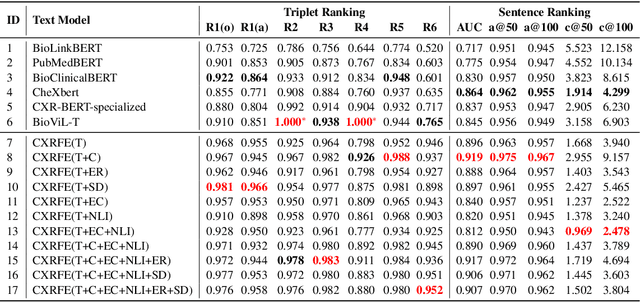

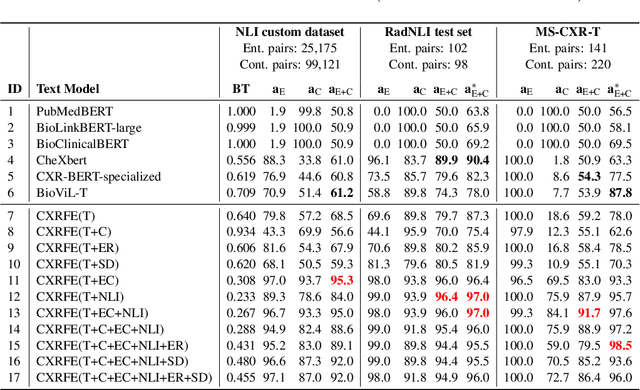
Abstract:Advancing representation learning in specialized fields like medicine remains challenging due to the scarcity of expert annotations for text and images. To tackle this issue, we present a novel two-stage framework designed to extract high-quality factual statements from free-text radiology reports in order to improve the representations of text encoders and, consequently, their performance on various downstream tasks. In the first stage, we propose a \textit{Fact Extractor} that leverages large language models (LLMs) to identify factual statements from well-curated domain-specific datasets. In the second stage, we introduce a \textit{Fact Encoder} (CXRFE) based on a BERT model fine-tuned with objective functions designed to improve its representations using the extracted factual data. Our framework also includes a new embedding-based metric (CXRFEScore) for evaluating chest X-ray text generation systems, leveraging both stages of our approach. Extensive evaluations show that our fact extractor and encoder outperform current state-of-the-art methods in tasks such as sentence ranking, natural language inference, and label extraction from radiology reports. Additionally, our metric proves to be more robust and effective than existing metrics commonly used in the radiology report generation literature. The code of this project is available at \url{https://github.com/PabloMessina/CXR-Fact-Encoder}.
Long Tail Image Generation Through Feature Space Augmentation and Iterated Learning
May 02, 2024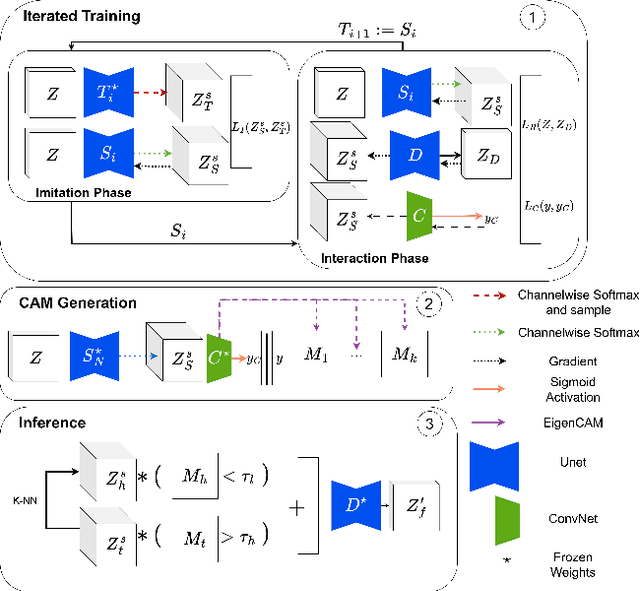
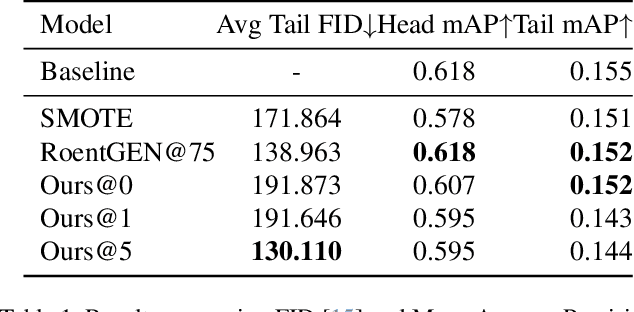
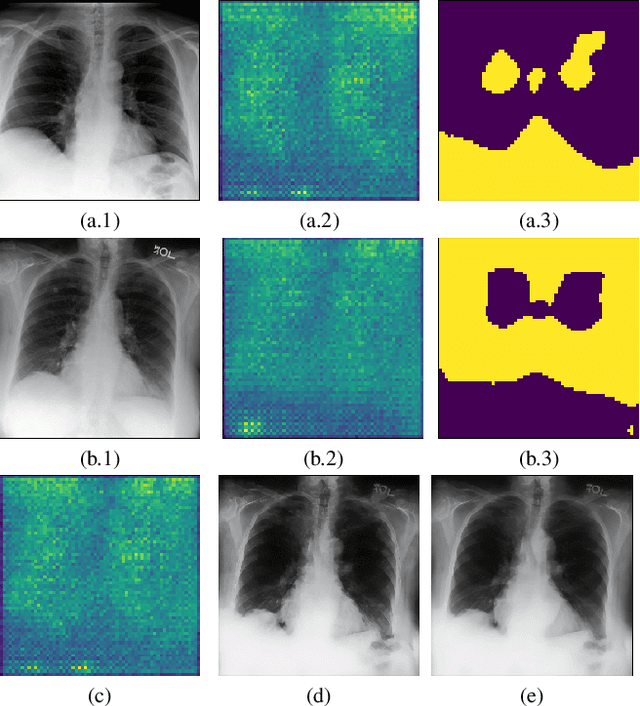
Abstract:Image and multimodal machine learning tasks are very challenging to solve in the case of poorly distributed data. In particular, data availability and privacy restrictions exacerbate these hurdles in the medical domain. The state of the art in image generation quality is held by Latent Diffusion models, making them prime candidates for tackling this problem. However, a few key issues still need to be solved, such as the difficulty in generating data from under-represented classes and a slow inference process. To mitigate these issues, we propose a new method for image augmentation in long-tailed data based on leveraging the rich latent space of pre-trained Stable Diffusion Models. We create a modified separable latent space to mix head and tail class examples. We build this space via Iterated Learning of underlying sparsified embeddings, which we apply to task-specific saliency maps via a K-NN approach. Code is available at https://github.com/SugarFreeManatee/Feature-Space-Augmentation-and-Iterated-Learning
Towards a Comprehensive Human-Centred Evaluation Framework for Explainable AI
Jul 31, 2023Abstract:While research on explainable AI (XAI) is booming and explanation techniques have proven promising in many application domains, standardised human-centred evaluation procedures are still missing. In addition, current evaluation procedures do not assess XAI methods holistically in the sense that they do not treat explanations' effects on humans as a complex user experience. To tackle this challenge, we propose to adapt the User-Centric Evaluation Framework used in recommender systems: we integrate explanation aspects, summarise explanation properties, indicate relations between them, and categorise metrics that measure these properties. With this comprehensive evaluation framework, we hope to contribute to the human-centred standardisation of XAI evaluation.
Stress Test Evaluation of Biomedical Word Embeddings
Jul 24, 2021


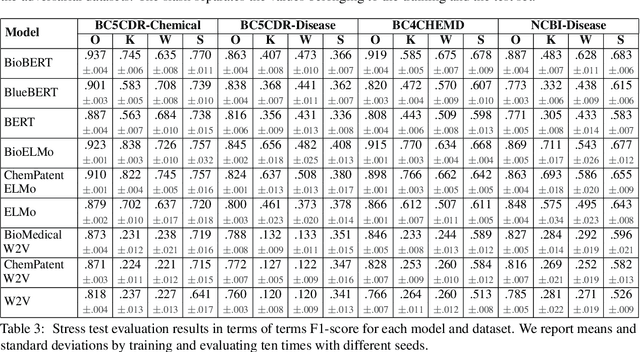
Abstract:The success of pretrained word embeddings has motivated their use in the biomedical domain, with contextualized embeddings yielding remarkable results in several biomedical NLP tasks. However, there is a lack of research on quantifying their behavior under severe "stress" scenarios. In this work, we systematically evaluate three language models with adversarial examples -- automatically constructed tests that allow us to examine how robust the models are. We propose two types of stress scenarios focused on the biomedical named entity recognition (NER) task, one inspired by spelling errors and another based on the use of synonyms for medical terms. Our experiments with three benchmarks show that the performance of the original models decreases considerably, in addition to revealing their weaknesses and strengths. Finally, we show that adversarial training causes the models to improve their robustness and even to exceed the original performance in some cases.
Graphing else matters: exploiting aspect opinions and ratings in explainable graph-based recommendations
Jul 07, 2021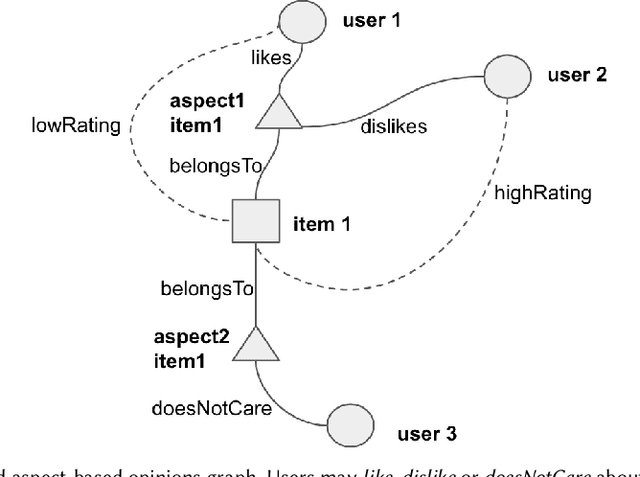
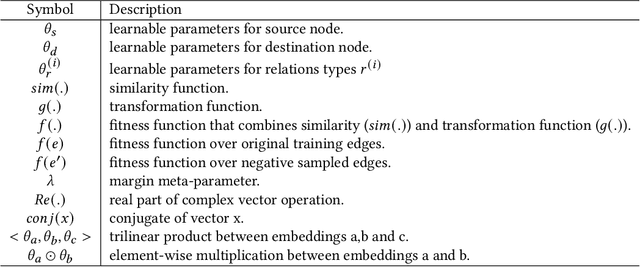
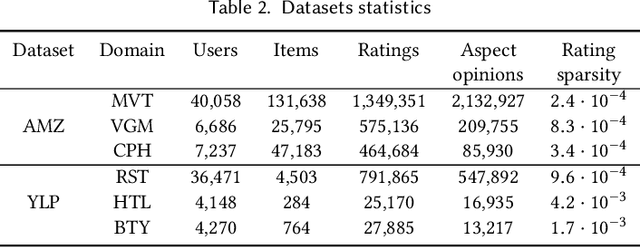
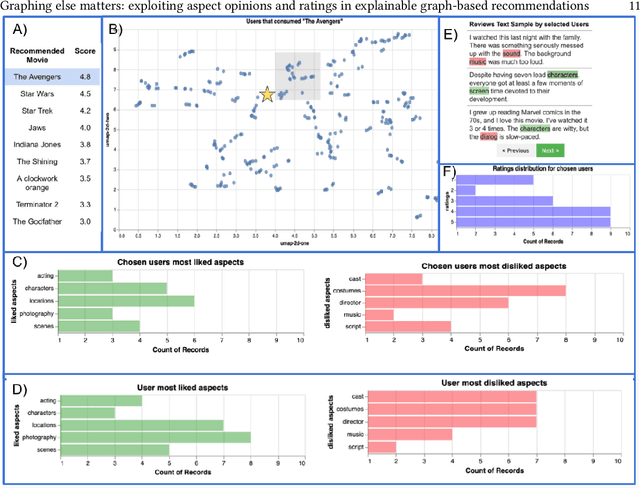
Abstract:The success of neural network embeddings has entailed a renewed interest in using knowledge graphs for a wide variety of machine learning and information retrieval tasks. In particular, current recommendation methods based on graph embeddings have shown state-of-the-art performance. These methods commonly encode latent rating patterns and content features. Different from previous work, in this paper, we propose to exploit embeddings extracted from graphs that combine information from ratings and aspect-based opinions expressed in textual reviews. We then adapt and evaluate state-of-the-art graph embedding techniques over graphs generated from Amazon and Yelp reviews on six domains, outperforming baseline recommenders. Our approach has the advantage of providing explanations which leverage aspect-based opinions given by users about recommended items. Furthermore, we also provide examples of the applicability of recommendations utilizing aspect opinions as explanations in a visualization dashboard, which allows obtaining information about the most and least liked aspects of similar users obtained from the embeddings of an input graph.
AHMoSe: A Knowledge-Based Visual Support System for Selecting Regression Machine Learning Models
Jan 28, 2021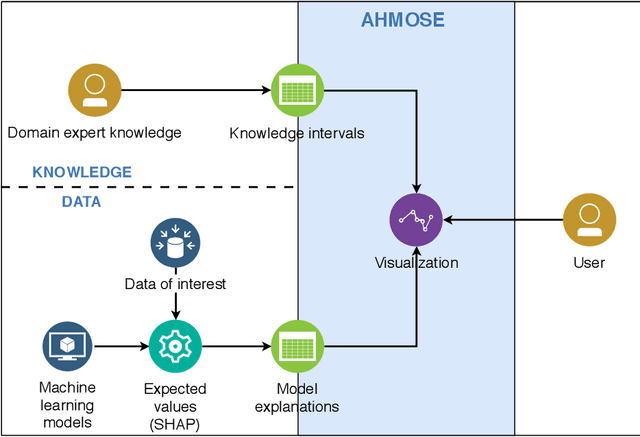
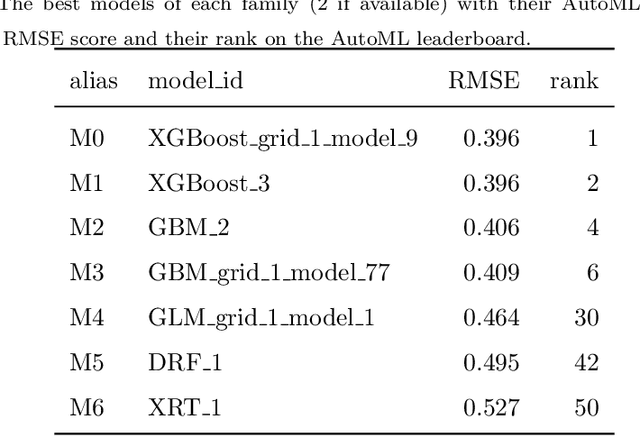
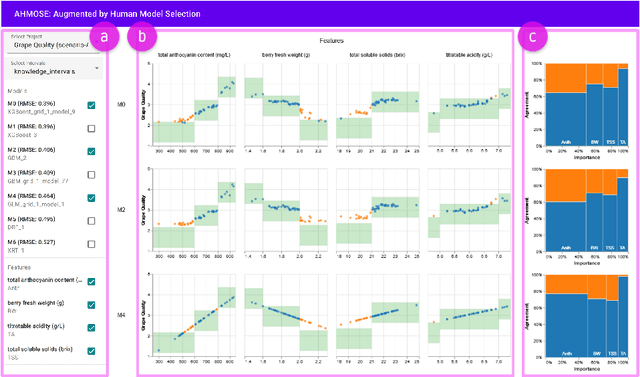
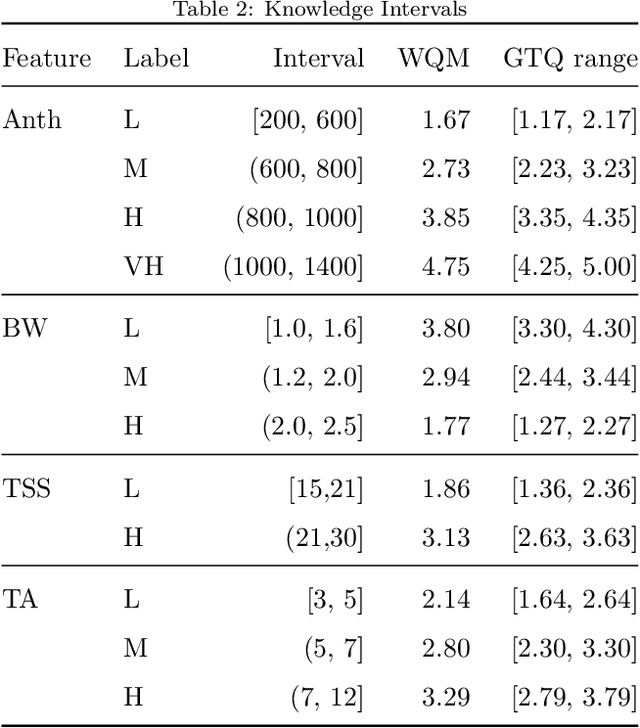
Abstract:Decision support systems have become increasingly popular in the domain of agriculture. With the development of Automated Machine Learning, agricultural experts are now able to train, evaluate and make predictions using cutting edge machine learning (ML) models without the need for much ML knowledge. Although this automated approach has led to successful results in many scenarios, in certain cases (e.g., when few labeled datasets are available) choosing among different models with similar performance metrics is a difficult task. Furthermore, these systems do not commonly allow users to incorporate their domain knowledge that could facilitate the task of model selection, and to gain insight into the prediction system for eventual decision making. To address these issues, in this paper we present AHMoSe, a visual support system that allows domain experts to better understand, diagnose and compare different regression models, primarily by enriching model-agnostic explanations with domain knowledge. To validate AHMoSE, we describe a use case scenario in the viticulture domain, grape quality prediction, where the system enables users to diagnose and select prediction models that perform better. We also discuss feedback concerning the design of the tool from both ML and viticulture experts.
Neural language models for text classification in evidence-based medicine
Dec 01, 2020
Abstract:The COVID-19 has brought about a significant challenge to the whole of humanity, but with a special burden upon the medical community. Clinicians must keep updated continuously about symptoms, diagnoses, and effectiveness of emergent treatments under a never-ending flood of scientific literature. In this context, the role of evidence-based medicine (EBM) for curating the most substantial evidence to support public health and clinical practice turns essential but is being challenged as never before due to the high volume of research articles published and pre-prints posted daily. Artificial Intelligence can have a crucial role in this situation. In this article, we report the results of an applied research project to classify scientific articles to support Epistemonikos, one of the most active foundations worldwide conducting EBM. We test several methods, and the best one, based on the XLNet neural language model, improves the current approach by 93\% on average F1-score, saving valuable time from physicians who volunteer to curate COVID-19 research articles manually.
 Add to Chrome
Add to Chrome Add to Firefox
Add to Firefox Add to Edge
Add to Edge